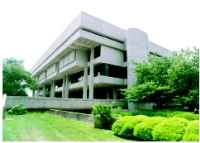Tech-Savvy Users Welcome Upgrades
Tech-Savvy Users Welcome Upgrades
 |
|
The City of Greensboro, NC, (left) employs over 2,500 workers, many of whom work in the Melvin Municipal Office Building (below). |
 |
The City of Greensboro has more than 230,000 residents and is the third-largest city in North Carolina. The city government provides police, utility, road construction, and maintenance services, plus manages solid waste collection, 18 fire stations, seven libraries, and 3,752 acres of parks and public land. More than 2,500 employees work for city departments full time. The city also employs additional staff for seasonal or hourly work, as needed.
As with most government entities, Greensboro is expected to meet its business needs and provide essential public services at minimal cost. In an effort to save time and taxpayers’ dollars and further automate its core business processes, the city implemented an integrated enterprise resource planning (ERP) system.
Greensboro was able to transition from a three-decade-old, COBOL-based, custom-written, mainframe environment to meet the diverse needs of its 20 departments—all while pursuing information technology (IT) best practices.
Greensboro partnered with Gartner, Inc., a provider of research and analysis of the IT industry. The group’s objective, in-depth analysis and “Decision Drivers” model, a series of questions answered by the major software providers, allowed Greensboro to make informed business and technology decisions.
The city was faced with the question of whether to use the internal staff that wrote the legacy system to write a new ERP system in-house or move to a purchased system. At the time, Greensboro had six programmers on staff.
“We were able to use the database of questions and answers from multiple suppliers and also add questions specific to the Greensboro process,” says Chris Payne, Collections Manager (formerly Assistant Purchasing Director), City of Greensboro. “From a functionality perspective, those questions basically became our specifications.”
Greensboro decided to purchase an ERP system.
Greensboro has a centralized purchasing office that is typically involved in larger, high-exposure projects. With the ERP project, a system buy-in was necessary from all department heads because organization-wide changes were imminent.
“From the highest level, down to the person entering a requisition, city employees received communications that the new ERP system would require changes in business processes,” says Payne.
“The key for us in evaluating software was the degree of flexibility,” says Larry Kerr, ERP Director, City of Greensboro.
As the backbone for the ERP system, the city chose Lawson Software’s out-of-the-box financial, human resources, and procurement applications. To maximize its IT investment, Greensboro used value-added technology extensions while implementing the integrated ERP system in 2002. The extensions allowed the city to deliver customized solutions to police, fire, safety, parks and recreation, and other groups without changes in programming—a key goal of the implementation.
“We wanted to start fresh with all the capabilities,” says Kerr, “so the message was, ‘We want to be able to pay people; we want to be able to buy things; and we want to be able to pay for the things we buy.'”
From an automation perspective, Greensboro employees had high expectations.
“Greensboro’s legacy system had been providing process automation for close to 30 years, and users expected a certain amount of sophistication,” says Ron Goodwin, Senior Buyer, City of Greensboro.
” Fortunately for us, not only could we duplicate much of the functionality, we were able to provide users with even more functionality.”
The legacy system was fully automated to the extent that users had the ability to transmit requisitions to purchasing, process purchase orders electronically, and print hard copies.
Implementation
“Using the Big Bang Theory, finance, procurement, human resources, and payroll were implemented simultaneously,” says Payne. “From a highlevel perspective, we were extremely pleased with the implementation.”
In the legacy system, users requested information with Easy Retrieve Reports, which required Greensboro’s IT department and many hours. Now, with two or three mouse clicks, users can access that data and much more anytime.
From a procurement perspective, Payne and Goodwin made extensive use of the tools that the ERP software provided to change the presentation layer, or the way the screens were presented to users.
Of the eight-person procurement department, Payne and Goodwin were the only ones working on the back end of the purchasing function.
“It is important to note that neither of us has any technical experience,” says Payne. “We were able to use these tools with very little support from either Lawson or our technical staff.”
The Design Studio extension reduced the need for end-user training. Greensboro was able to remove all unused fields for its business processes and rename and reorganize fields to make the user interface resemble what end users had experienced in their previous systems.
“By using Design Studio to make these changes before implementation, we were able to duplicate a lot of the look and feel within the initial rollout to ensure the system was well accepted,” says Payne.
“I don’t want to use the words ‘ customize’ or ‘modify,’ but what we were presenting our users was more in line with what they had seen in our legacy system,” says Payne.
For example, if the software used the term “ship to,” the label was changed to “deliver to,” to reflect the legacy interface.
“We were also able to organize the screens in a similar format so the flow of data entry was similar to the legacy system,” says Payne. “It significantly reduced our training curve because our customers were familiar with the terminology and the process of entering and electronically transmitting requisitions.”
“Design Studio has helped us simplify complex forms, add commands to launch Crystal Reports [a report generating software program], and add custom scripts for task information,” says Kerr.
Greensboro further enhanced its purchasing process by linking Design Studio with Process-Flow, an application that streamlines the steps required to obtain approvals by automatically routing requisitions and other documents along the appropriate approval channels.
ProcessFlow allows the city to control computer purchases by enabling users to evaluate requests quickly and route them to decision-makers. Software requisitions are automatically routed to MIS, where versions can be checked and updated, if necessary, before going on to the purchasing department.
“When we make the software purchase, we are buying the correct version that MIS is supporting,” says Payne.
For orders under $5,000, requests go directly to purchasing.
For capital and technical purchases (e.g. computer software, printers, peripherals, etc.), requisitions are routed to purchasing, budgeting, and MIS, enabling all three departments to see the status of approvals.
By automating this process, the city has reduced the volume of paperwork within its purchasing group and has shortened the approval cycle for these types of purchase orders by at least one day.
“With more than 500 capital and technical purchase orders processed annually using this tool, shaving one day off the approval process actually translates into a time savings of 450 days per year for the city,” Goodwin says. “This is impressive when you consider it only took our business staff, not IT, one week to develop the Process-Flow. This is proof that users don’t need deep Java script or computer programming knowledge to use these technology extensions well.”
When Greensboro’s Solid Waste Department orders a $225,000 garbage truck, the requisition arrives in the purchasing department for review. Once approved, the requisition goes on to the budget department for verification of fund availability and account number assignment, then back to purchasing.
If someone were to try to buy a large piece of equipment that was not approved by city council and in the budget, the budget department would investigate.
When the city makes an adjustment to a budget, the software application automatically updates every department. This information includes available budget for each object of expense, how much has already been encumbered, how much has been pre-encumbered, and how much has actually been spent to date.
“Providing this information allows departments to do self-service requisitions via Web browsers,” says Steve Jolly, Government and Education Director, Lawson Software. “Departments are not wasting time filling out requisitions when they don’t have any money.”
When Greensboro’s area codes changed, the city’s legacy system had no efficient process for updating the new information. Staff spent countless hours manually updating several thousand vendor records affected by the change. Now, an extension allows the city to quickly address these types of data changes.
The same extensions also helped the city simplify payment of seasonal and occasional employees. To schedule and issue paychecks for these employees, Greensboro used the application to give department supervisors a simple screen in which they enter two data fields: employee number and hours worked. The ERP system captures and uploads this information for each payroll cycle.
“There is a tremendous move in the private sector to become more strategic, and that is filtering over to the government,” says Payne. “In our case, we are a centralized purchasing office and we are always working to add more value to the process.”
It’s a constant challenge for the Greensboro Purchasing Division to create new procedures and policies and substantiate value to the organization. The division is able to do that by providing users with data, automating processes, and getting products delivered to the end users earlier in the process at the right price.
To be strategic to the point of preplanning the purchasing needs for a particular user or department is a division goal. By ensuring that end users have the things that they need to focus on their specific jobs, the division helps alleviate the I-can-buy-it-faster-or-at-a better-price-myself mentality.
The purchasing department’s use of technology and strategic analysis of bids allows Goodwin and colleagues to look beyond lowest bid to provide a total cost recommendation for purchases that save the organization money over the life of an asset.
“As a support group, we try our best to work with the end users at all times,” says Goodwin. “I think that goes a long way.”
PRO PATHWAYSCity of Greensboro, NC www.govinfo.bz/4356-267 Gartner, Inc. www.govinfo.bz/4356-268 Lawson Software www.govinfo.bz/4356-269 |




















